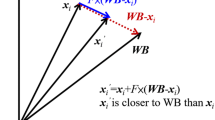Abstract
This study presents a knowledge-based cooperative differential evolution (KCoDE) for neural fuzzy inference systems to solve nonlinear control system problems. KCoDE decomposes the fuzzy system into subpopulations, and each individual within each subpopulation evolves separately. The KCoDE method uses five mutation strategies of differential evolution as the knowledge sources to generate a new population space to influence the population space. The exemplary individuals are selected from the population space to the belief space. The belief space in KCoDE is the information repository in which individuals can store their experiences to guide others. Finally, the experimental results show that the proposed KCoDE method better approximates the global optimal solution and has a faster convergence rate than the other methods.













Similar content being viewed by others
References
Chen CH, Lin CJ, Lin CT (2008) A functional-link-based neuro-fuzzy network for nonlinear system control. IEEE Trans Fuzzy Syst 16(5):1362–1378
Chen CH, Lin CJ, Lin CT (2009) Nonlinear system control using adaptive neural fuzzy networks based on a modified differential evolution. IEEE Trans Syst Man Cybern C Appl Rev 39(4):459–473
Coelho LS, Mariani VC (2006) Combining of chaotic differential evolution and quadratic programming for economic dispatch optimization with valve-point effect. IEEE Trans Power Syst 21(2):989–996
Eiben AE, Hinterding R, Michalewicz Z (1999) Parameter control in evolutionary algorithms. IEEE Trans Evol Comput 3(2):124–141
Fan HY, Lampinen J (2003) A trigonometric mutation operation to differential evolution. J Global Optim 27(1):333–359
Farag WA, Quintana VH, Lambert-Torres G (1998) A genetic-based neuro-fuzzy approach for modeling and control of dynamical systems. IEEE Trans Neural Netw 9(5):756–767
Garcia-Pedrajas N, Hervas-Martinez U, Ortiz-Boyer D (2005) Cooperative coevolution of artificial neural network ensembles for pattern classification. IEEE Trans Evol Comput 9(3):271–302
Hansen N, Ostermeier A (2001) Completely derandomized self-adaptation in evolution strategies. Evol Comput 9(2):159–195
Hauser J, Sastry S, Kokotovic P (1992) Nonlinear control via approximate input-output lineariztion: the ball and beam example. IEEE Trans Autom Control 37(3):392–398
Heyes C, Huber L (2000) The evolution of cognition. MIT Press, Cambridge
Hsu CH, Juang CF (2012) Evolutionary Robot wall-following control using type-2 fuzzy controller with species-DE activated continuous ACO. IEEE Trans Fuzzy Syst (to appear)
Juang CF, Chang PH (2010) Designing fuzzy-rule-based systems using continuous ant-colony optimization. IEEE Trans Fuzzy Syst 18(1):138–149
Juang CF, Lo C (2008) Zero-order TSK-type fuzzy system learning using a two-phase swarm intelligence algorithm. Fuzzy Sets Syst 159(21):2910–2926
Juang CF, Hsiao CM, Hsu CH (2010) Hierarchical cluster-based multispecies particle-swarm optimization for fuzzy-system optimization. IEEE Trans Fuzzy Syst 18(1):14–26
Khushaba RN, Al-Ani A, Al-Jumaily A (2011) Feature subset selection using differential evolution and a statistical repair mechanism. Expert Syst Appl 38(9):11515–11526
Lipowski A, Lipowska D (2012) Roulette-wheel selection via stochastic acceptance. Phys A Stat Mech Appl 391(6):2193–2196
Michalewicz Z, Schoenauer M (1996) Evolutionary algorithms for constrained parameter optimization problems. Evol Comput 4(1):1–32
Patra JC, Pal RN, Chatterji BN, Panda G (1999) Identification of nonlinear dynamic systems using functional link artificial neural networks. IEEE Trans Syst Man Cybern B 29(2):254–262
Pena-Reyes CA, Sipper M (2001) Fuzzy CoCo: a cooperative-coevolutionary approach to fuzzy modeling. IEEE Trans Fuzzy Syst 9(5):727–737
Perez-Godoy MD, Rivera AJ, Berlanga FJ, Del Jesus MJ (2010) CO2RBFN: an evolutionary cooperative-competitive RBFN design algorithm for classification problems. Soft Comput 14(9):953–971
Potter MA, De Jong K (1994) A cooperative coevolutionary approach to function optimization. In: Proceedings of the third conference on parallel problem solving from nature, pp 249–257
Potter MA, De Jong K (2000) Cooperative coevolution: an architecture for evolving coadapted subcomponents. Evol Comput 8(1):1–29
Price KV, Storn RM, Lampinen JA (2005) Differential evolution: a practical approach to global optimization. Springer, Germany
Qin AK, Huang VL, Suganthan PN (2009) Differential evolution algorithm with strategy adaptation for global numerical optimization. IEEE Trans Evol Comput 13(2):398–417
Rahnamayan S, Tizhoosh HR, Salama MMA (2008) Opposition-based differential evolution. IEEE Trans Evol Comput 12(1):64–79
Reynolds RG (1994) An introduction to cultural algorithms. In: Proceedings of the third annual conference evolutionary programming, pp 131–139
Reynolds RG, Peng B, Ali MZ (2008) The role of culture in the emergence of decision-making roles: an example using cultural algorithms. Complexity 13(3):27–42
Robinson J, Rahmat-Samii Y (2004) Particle swarm optimization in electromagnetic. IEEE Trans Antennas Propag 52(2):397–407
Runarsson TP, Yao X (2000) Stochastic ranking for constrained evolutionary optimization. IEEE Trans Evol Comput 4(3):284–294
Saleem S, Reynolds R (2000) Cultural algorithms in dynamic environments. In: Proceedings of the congress on evolutionary computation, pp 1513–1520
Storn R (1999) System design by constraint adaptation and differential evolution. IEEE Trans Evol Comput 3(1):22–34
Storn R, Price KV (1997) Differential evolution—a simple and efficient heuristic for global optimization over continuous spaces. J Glob Opt 11(4):341–359
Tan KC, Yang YJ, Goh CK (2006) A distributed cooperative coevolutionary algorithm for multiobjective optimization. IEEE Trans Evol Comput 10(5):527–549
Tanomaru J, Omatu S (1992) Process control by on-line trained neural controllers. IEEE Trans Ind Electron 39(6):511–521
van den Bergh F, Engelbrecht AP (2004) A cooperative approach to particle swarm optimization. IEEE Trans Evol Comput 8(3):225–239
Wang WY, Cheng CY, Leu YG (2004) An online GA-based output-feedback direct adaptive fuzzy-neural controller for uncertain nonlinear systems. IEEE Trans Syst Man Cybern B 34(1):334–345
Wynne CD (2001) Animal cognition: the mental lives of animals. Palgrave Macmillan, Great Britain
Yang Z, Tang K, Yao X (2008) Large scale evolutionary optimization using cooperative coevolution. Inf Sci 178(15):2985–2999
Yao X, Liu Y (1997) A new evolutionary system for evolving artificial neural networks. IEEE Trans Neural Netw 8(3):694–713
Acknowledgments
This study was sponsored by the National Science Council, Taiwan, R.O.C., under Grant NSC 101-2221-E-150-085.
Author information
Authors and Affiliations
Corresponding author
Additional information
Communicated by Y. Jin.
Rights and permissions
About this article
Cite this article
Chen, CH., Yang, SY. A knowledge-based cooperative differential evolution for neural fuzzy inference systems. Soft Comput 17, 883–895 (2013). https://doi.org/10.1007/s00500-012-0959-5
Published:
Issue Date:
DOI: https://doi.org/10.1007/s00500-012-0959-5




